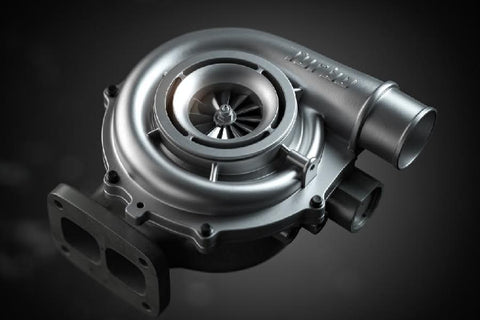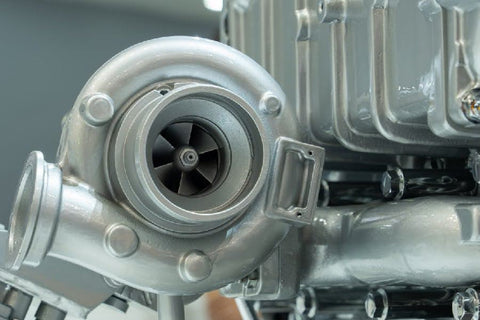Turbochargers are forced induction devices in internal combustion engines powered by the flow of exhaust gasses. Vehicle enthusiasts and those wanting to optimize vehicle performance add turbos. But there are different types of turbochargers, all with their advantages.
So, you must first understand the various types available to add the best turbocharger to your vehicle. Keep reading, as we will cover the different turbochargers below.

source: shutterstock.com/ Photo Contributor: Maxx-Studio
Types of Turbochargers
Single turbocharger
A single turbocharger or a simple turbo is the most common type. You can find single turbochargers in both gas and diesel engines. A single turbo is the most cost-effective way to boost the power and efficiency of an engine.
They are also relatively simple to install, and singular turbos have almost limitless variability. The different compressor wheel sizes and turbines in single turbos lead to various torque characteristics.
Large turbos provide high power, whereas smaller turbochargers offer better low-end growl. This is because smaller turbos roll up faster. The single turbos may match even the power of large, naturally aspirated engines despite using a smaller engine.
However, one of the potential drawbacks of a single turbo is that they have a narrow RPM range.
Twin turbocharger
Twin turbochargers are essentially two single turbos added to an engine. You may accomplish this for engines with a V6 or V8 by designating one turbo to operate with each bank of cylinders.
As a replacement, a larger turbo might be incorporated at higher RPMs and one smaller turbo at lower RPMs. This type is also known as a dual shaft turbocharger because it includes two turbos.
Furthermore, better torque at low speeds (minimizing turbo lag) and power at high RPMs are provided by this design. The dual sequential turbocharging enables a greater operating RPM range. Naturally, the complexity and related expenses increase dramatically with the number of turbos.
Variable geometry turbocharger
A ring of aerodynamically formed rotors is often present in the turbine housing near the turbine inlet of VGTs. These vanes revolve to change the cross-sectional area and gas swirl angle in turbos used in automobiles and light-duty trucks.
Peak performance is achieved by matching the engine's RPM with the turbo's area-to-radius (A/R) ratio, which these internal vanes alter. By raising exhaust gas velocity at low RPM, a low A/R ratio enables the turbo to spool up more quickly.
So, a higher RPM results in an increased A/R ratio, which permits more airflow. This produces a wide and smooth torque band and a low boost threshold, reducing turbo lag.
Moreover, VGTs are more commonly found in diesel engines, where exhaust gasses have a lower temperature. Due to the high temperature of the exhaust gasses, unusual heat-resistant materials have to be used to make the vanes to prevent damage.
Electric turbocharger
Electric turbochargers are a relatively new addition to the automotive and turbocharger industry. As they are electric, these types of turbos are vastly different from other turbochargers.
When a traditional turbo is not the most efficient at lower engine speeds, an electric turbo is utilized to help a regular turbocharger and remove turbo lag. An electric motor rotates the turbo's compressor at low speeds and at startup until the exhaust volume's power is sufficient to operate the turbocharger.
This method greatly expands the RPM range in which the turbo will function efficiently. Although there are several drawbacks, electronic turbochargers solve every drawback associated with traditional turbochargers.
Twin-scroll turbocharger
An even more efficient option than a simple turbo is the twin-scroll turbocharger. In a twin-scroll turbocharger, the exhaust gasses from both cylinders go into two separate channels.
Both channels converge into single turbine intel, separating the exhaust pulses. The pulses' separation helps improve spool-up time and overall efficiency.
The difference in turbos when it comes to simple and twin-scroll is that the latter produces a boost on a wider powerband. Twin-scroll turbos are perfect for smaller engines as they generate much power throughout the entire rev engine.
Another benefit of a twin-scroll turbo includes better exhaust temperature management. Also, by separating exhaust pulses, twin-scroll turbos may help reduce back pressure, increasing the engine's longevity.
Variable twin-scroll turbo
Variable twin-scroll turbos are the result of combining the best features of variable geometry and twin-scroll turbos. This allows them to produce a power boost while also being highly efficient.
Variable twin-scroll turbos are also more cost-efficient than variable geometry turbos. With a variable twin-scroll turbo, there is also greater flexibility in improving performance across the RPM range.
Plus, the ability of these turbos to vary the turbine inlet's geometry allows for better control over exhaust gas flow and turbine response.
Furthermore, variable twin-scroll turbos are great in high-performance applications. This is because they benefit from these engines' instantaneous response and power boost.
Turbo Compressor Types
The compressor in a turbo is the device used to inject the airflow. In turbochargers, compressors are the cold parts that inject airflow into the engine's cylinders. It injects the airflow with the aid of the compressor wheel.
Generally, most turbos use centrifugal compressors. But there are also axial compressors. Both centrifugal and axial compressors produce a continuous flow of compressed air. In contrast, electric turbochargers use electric motors to power the compressor.
Factors to Consider When Choosing a Turbocharger
Engine size and output
The engine's size and output are among the first factors you must consider when choosing a turbocharger. Each turbo is designed to support a specific horsepower and engine displacement range.
For example, if a turbo is too large for the engine, it will lead to a turbo lag. However, if the turbo is too small for your engine, it may not be able to reach your horsepower target. So, ensure the turbocharger you buy fits your vehicle's engine.
The right turbocharger should be compatible with your vehicle. The wrong turbocharger will struggle to generate the needed boost. This will lead to slow acceleration. Also, a wrong turbo may compromise the overall efficiency of your engine.
Budget
Another important factor in choosing a turbocharger is your budget. Some turbocharger types are more expensive than others. For example, the price differences between a single turbo and a variable geometry turbocharger will undoubtedly be significant.
This is why you should consider how much you are ready to spend on your turbo. Have the budget in mind before you start shopping. We recommend setting a higher budget if you can afford to spend more, as your choices will be greater.
Yet, with us, you can find repurposed, used, and brand-new turbochargers for sale at various prices. In fact, you may find even the one you think you cannot afford at a reasonable price.
Desired power gains
You should also think about the horsepower you want to achieve. Generally, turbochargers can produce power gains between 75 to 150 horsepower. However, the following factors influence the power gains you may experience:
- The engine's compression ratio
- Boost pressure
- The size of the turbo
This means that buying the largest turbocharger does not correlate to getting the desired power gains. You must find a balance between engine design and boost pressure for the desired power gains.
Driving habits
You must also take into consideration your driving habits. Proper maintenance and driving habits ensure the longevity of a turbocharger. If you decide to buy a turbo for your vehicle, remember not to drive before the oil warms up.
The oil lubricates the turbo bearings; you can wear down the turbocharger fast without it. Also, as turbochargers run incredibly hot, you must let the oil cool down before turning the ignition off. If you do not let the oil cool down, it can damage the internal components of the turbo.

source: shutterstock.com/ Photo Contributor: Scharfsinn
Conclusion
How many types of turbos are there? There are six types of turbochargers, the ones that we covered above. This includes single, twin, variable geometry, electric, twin-scroll, and variable twin-scroll turbo.
Each type has its advantages, so choosing the one compatible with your vehicle is important to optimize performance.



